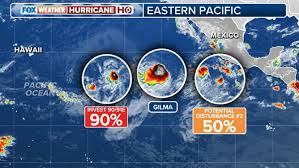
Hawaii, a tropical paradise in the central Pacific, is renowned for its stunning landscapes, vibrant cultures, and temperate climate. However, despite its idyllic image, Hawaii is not immune to the impacts of tropical cyclones. These powerful meteorological phenomena can significantly affect the islands, bringing heavy rains, strong winds, and storm surges. Understanding how developing tropical cyclones in the Pacific can impact Hawaii requires an examination of the nature of these storms, the unique geographic and meteorological conditions of the Hawaiian Islands, and the potential consequences of these impacts.
Table of Contents
Tropical Cyclones: Formation and Pathways
Tropical cyclones, also known as hurricanes in the North Atlantic and typhoons in the Northwest Pacific, are intense circular storms that originate over warm tropical oceans. They are characterized by low atmospheric pressure, high winds, and heavy rain. Cyclone formation typically involves several key conditions: warm sea surface temperatures, sufficient moisture in the atmosphere, and low vertical wind shear.
In the Pacific Ocean, tropical cyclones generally form between 5° and 20° latitude, where the sea surface temperatures are sufficiently warm to fuel these storms. The development of a tropical cyclone often begins as a tropical disturbance, which can intensify into a tropical depression, then a tropical storm, and potentially into a full-fledged hurricane or typhoon.
The Hawaiian Islands’ Geographic and Meteorological Context
Hawaii is situated roughly midway between North America and Asia, isolated in the central Pacific Ocean. The archipelago comprises eight main islands and numerous smaller islets, positioned around the 20th parallel north. This central location places Hawaii in the path of tropical cyclones that form in the Pacific Ocean. However, several geographic and meteorological factors influence how these cyclones impact the islands.
One crucial factor is the Hawaiian Islands’ exposure to cyclonic activity. While Hawaii is not located in the primary cyclone formation zones, it can still be affected by storms that move westward from the central Pacific. The North Pacific High, a semi-permanent high-pressure system located to the north of Hawaii, influences the movement of tropical cyclones. Typically, this high-pressure system steers cyclones away from the islands. However, variations in its position can occasionally allow cyclones to move closer to or even impact Hawaii.
Historical Impacts of Tropical Cyclones on Hawaii
Hawaii has experienced several notable impacts from tropical cyclones in its history. For instance, Hurricane Iniki in 1992 was one of the most devastating storms to hit the islands. It struck the island of Kauai with winds exceeding 140 mph, causing widespread destruction and significant economic losses. Iniki’s impact highlighted the vulnerability of the Hawaiian Islands to tropical cyclones, despite their general infrequency.
More recently, Hurricane Lane in 2018 brought record-breaking rainfall and severe flooding to the Big Island and Oahu, underscoring the potential for significant damage from even less intense cyclones. While Lane did not make landfall as a hurricane, it still demonstrated how tropical cyclones can cause considerable disruption and damage through heavy rainfall and flooding.
The Role of Climate Change
Climate change is altering the dynamics of tropical cyclones, with potential implications for Hawaii. Rising global temperatures are increasing sea surface temperatures, which can provide more energy for tropical cyclones, potentially making them more intense. Additionally, changes in atmospheric circulation patterns could affect the paths and frequency of cyclones. For Hawaii, this means that while the overall frequency of cyclones may not increase significantly, the intensity of storms that do approach the islands could be greater.
Increased sea levels, driven by the melting of polar ice and thermal expansion of seawater, can exacerbate the impacts of storm surges associated with tropical cyclones. This combination of rising sea levels and more intense storms could lead to more severe coastal flooding and erosion in Hawaii, impacting infrastructure and ecosystems.
Mitigation and Preparedness
Given the potential impacts of tropical cyclones, Hawaii has developed extensive preparedness and mitigation strategies. The state has established robust emergency response systems, including early warning systems, evacuation plans, and public education campaigns to ensure residents are prepared for potential cyclones. Building codes in Hawaii are designed to withstand high winds and flooding, and coastal developments are increasingly subject to regulations that consider future risks.
Moreover, ongoing research into cyclone behavior and climate change is crucial for refining these preparedness strategies. Improved forecasting models and real-time monitoring technologies help provide more accurate predictions of cyclone paths and intensities, allowing for better-informed decisions and timely evacuations if necessary.
Conclusion impact
In conclusion, while Hawaii’s geographic location provides some natural protection against tropical cyclones, it is not immune to their impacts. The islands’ vulnerability to these storms is influenced by their exposure to the central Pacific, the variability of atmospheric conditions, and the broader effects of climate change. Historical events like Hurricane Iniki and more recent storms such as Hurricane Lane illustrate the significant impact that tropical cyclones can have on Hawaii.
As climate change continues to affect storm patterns and intensities, it is crucial for Hawaii to maintain and enhance its preparedness and mitigation strategies to protect its residents and infrastructure. The resilience of the Hawaiian Islands depends on their ability to adapt to the evolving threats posed by tropical cyclones in an increasingly changing climate.







